Source: Navy Department Library Special Collections.

The Navy Department Library
Anti-Suicide Action Summary
| August 1945 | COMINCH P-0011 |
UNITED STATES FLEET
HEADQUARTERS OF THE COMMANDER IN CHIEF
NAVY DEPARTMENT
WASHINGTON 25, D. C.
31 August 1945
Anti-Suicide Action Summary, issued as CominCh P-0011, deals with Japanese aerial suicide attacks against our surface forces in the Pacific.
The publication discusses anti-suicide results through May 1945, enemy tactics and weapons, existing and proposed defense tactics and equipment.
This Anti-Suicide Action Summary is SECRET and shall be safeguarded in accordance with the provisions of Article 76, U.S. Navy Regulations, 1920. When no longer required it shall be destroyed by burning. No report-of destruction is required.
Transmission by Registered Guard Mail or U.S. Registered Mail is authorized in accordance with Article 76 (15) (e) and (f), U.S. Navy Regulations.
B. H. Bieri,
Acting Chief of Staff.
TABLE OF CONTENTS
| Page | ||
| Chapter I. | Introduction | 1 |
| II. | Enemy Tactics | 5 |
| III. | Ship Defense | 10 |
| IV. | Air Defense | 17 |
| V. | Special Defense Problems | 20 |
| VI. | Task Force 69 | 25 |
| VII. | New Weapons | 27 |
| Bibliography | 30 |
LIST OF EFFECTIVE PAGES
| Page | |
| Letter of Promulgation | i |
| Table of Contents and List of Effective Pages | i |
| Distribution List | ii |
| Chapter I | 1-4 |
| Chapter II | 5-9 |
| Chapter III. | 10-16 |
| Chapter IV | 17-19 |
| Chapter V | 20-24 |
| Chapter VI | 25-26 |
| Chapter VII | 27-29 |
| Bibliography | 30 |
--i--
DISTRIBUTION LIST
Standard Navy Distribution List Part 1--15 June 1945
List 1 a(5) less ComSoAtlFlt, ComNavNaw, ComTwelfthFlt, ComTenthFlt, send CinCPac 20 copies; b(2); c(2) send ComAirForPac 10 copies; d(2); e(2); f(l) only to ComSubLant and ComSubForPac; g(2); h(2); i(2); j(4); k(2); 1(2) only to ComMinPac, ComNavGrp China, ComNavLiaison Officer, British Pac-Flt, ComNav Liaison Officer, British East Indies.
List 2 b(2); c(2) only to ASDevLant; c(l) less Airship A/S Tr. DetachmentLant; f(2); g(2); h(l); m(2); n(2) only to LCI(L), LSM, LST, LCS(L) (3) Flotillas; o(2) MinRons only; r(2); only to MTB FLOT 1, MTBRon SPac, MTBRON PacFlt, MTBRON 7th Fit; v(2) send TransDivs (1).
List 3 b(4), c(2); d(2); f(4); h(l) less Coast Guard Cutters; m(4); o(l); p(]); q(l); t(4); u(4); v(4); x(2); y(l); z(l); ff(l); tt(l); uu(l); vv(l); ww(l); zz(l); ggg(l); gggg(l); hhhh(l);
jjjj(D; mid);
Standard Navy Distribution List Part 2--1 June 1945
List 6 a(2) less 17th NavDisRep, SRNC, PRNC, SamDefGrp; c(l) Adm. & Mil. Com. San Diego, Calif, only.
List 7 a-l(2); c-l(2) only to NOB, Navy #115; f(5); g(30); h(5); i-3(5).
List 8 h(2) only to RESLAB Anacostia; n-1 only to NTSch (Tactical Radar) Hollywood, Fla. .(1); AATr. Cen, Lido Beach, Long Island, N. Y. (2); Naval Radar Tr. Sch. St. Simons Island, Ga. (1); Ordnance and Gunnery Schools, NYD, Wash., D. C. (2); FSS, NOB, Norfolk, Va. (2); FSS NAVREPBASE, San Diego (2); n-10 only to Mine Craft Training Center and CIC Group Tr. Center, Little Creek, Norfolk, Va. (2); Fleet Gunnery & Torpedo School, Navy #91 (10); PacFlt-RadarCenter, Navy #91 (2); x (2).
List 10 m (3) only to Ford Instrument Co., Long Island City, N. Y.; ss (2) only to FltAdminOff at NYD's.
List 11 SecNav (1); UnderSecNav (1); AsstSecNavAir (1); GenBd (1); BuAero (6); BuPers (6); CNO (6); BuOrd (G); BuShips (6); BuY& D (2); USMC (10); USCG (10).
Plus Air Intelligence Group distribution to Marine and Naval Aviation Squadrons, Groups and Wings (800).
Plus Special Distribution List.
Note.--Numbers in parentheses indicate number of copies sent to each addressee.
--ii--
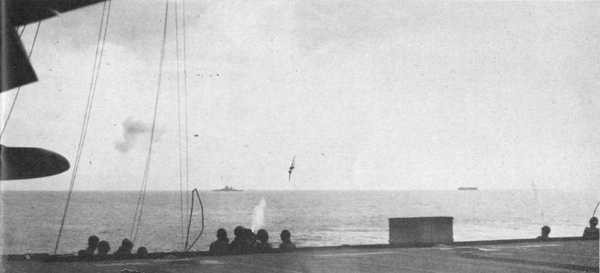
Chapter I
INTRODUCTION
Suicide air attacks against our surface forces, inaugurated during the Philippines campaign, were continued at an increased tempo during the Okinawa operation.
That the Japanese will intensify their suicidal effort in coming months is certain. The pattern of the enemy's defense is taking predictable form. The following may be expected:
1. The Japanese air force of 8-9000 combat and training planes will be conserved for suicidal attacks on our surface forces. Carrier and land-based air strikes will meet little or no air opposition. Even bombardments of Japanese coastal cities, such as those by ships of Task Force 38 in mid-July, will not draw the Japanese air force out of hiding.
2. The supreme suicidal effort of the enemy will coincide with the next amphibious operation. Rather than picket stations, as in the Okinawa campaign, suiciders will concentrate on troop and cargo transports and large amphibious craft in an effort to defeat the landing operation at the beachhead.
3. Float and training planes, as well as combat types, will be employed in large numbers. To avoid losing a large proportion of their planes to our fighters, attacks will be made chiefly at dusk and night, when our air cover is weakest. Dawn attacks in diminishing numbers may be expected.
During the period February-May, which saw the occupation of Iwo Jima, strikes against Tokyo and Kyushu, and the invasion of Okinawa, an estimated 1,100 enemy aircraft sortied with suicidal intent to attack our surface forces. Of these about
500, or 45 percent, were splashed or turned back by CAP (Combat Air Patrol); 420, or 38 percent, missed ships as a result of AA. fire; 180, or 17 percent, hit ships. Of the 600 which were taken under fire by ships approximately 180, or 30 percent, hit ships; 78, or 13 percent, missed ships but damaged them; 342, or 57 percent, missed ships and caused no damage.
____________
Note.--All planes which miss ships in their suicide crashes are classified in this publication as AA. successes, whether or not they cause damage.
--1--
Following is a box score showing results by months for those planes which arrived within gun range of ships:
Table I
| Feb. | Mar. | Apr. | Total | Oct-Jan. | Total | |
|---|---|---|---|---|---|---|
| Total planes | 123 | 219 | 978 | 1,320 | 1,616 | 2,936 |
| Suicide planes | 18 | 42 | 348 | 408 | 376 | 784 |
| Nonsuicide planes | 105 | 177 | 630 | 912 | 1, 240 | 2, 152 |
| Suicide AA. kills | 10 | 32 | 270 | 312 | 256 | 568 |
| Nonsuicide AA. kills | 7 | 38 | 108 | 150 | 206 | 356 |
| Suicide hits | 8 | 10 | 78 | 96 | 120 | 216 |
| Nonsuicide hits | 1 | 10 | 6 | 17 | 41 | 58 |
Note.--In the foregoing figures the number of suicide planes includes not only those planes which definitely attempted to crash into ships but also a proportion of the planes shot down by AA. before they demonstrated their intentions. This proportion is determined by separating the uncertain kills according to the ratio of known suiciders to known nonsuiciders.
It will be seen in table I that, even during the month of April, when the enemy made his strongest suicidal effort, only 35 percent of the planes taken under fire by ships were suicide planes. Others bombed, made torpedo attacks, used harassing tactics, or snooped. However,
the percentage of total planes attacking which intended to suicide increased from 24 percent in the Philippines to 31 percent in the succeeding three months, establishing a trend which is expected to continue at an accelerated rate.
AA. EFFECTIVENESS
An increase in AA. effectiveness is indicated in the tabulations in table I. Following are the numbers of planes shot down and the percentages of the total taken under fire in the period October-April:
Table II
| Oct.-Jan. | Feb.-Apr. | Totals | |
|---|---|---|---|
| Suicide kills | 256 (68%) | 312 (76%) | 568 (72%) |
| Nonsuicide kills | 206 (16%) | 150 (16%) | 356 (16%) |
| Totals | 462 (29%) | 462 (35%) | 924 (31%) |
It is interesting to note that the percentage of AA. successes increased only against suicide planes. This may be attributed chiefly to the following:
1. Comparative lack of surprise attacks as a result of (a) greater ship alertness, and (b) early warning by DD pickets.
2. Enemy use of obsolete aircraft, which were vulnerable to AA. fire and were operated by unskilled pilots.
3. Ships' practice of opening fire at long range, using a high percentage of VT fuzes, thus increasing the percentage of 5-inch kills.
AA. successes against those suicide planes which actually made crash attempts, and enemy successes in scoring hits and damaging near misses, are shown in the following table:
--2--
Table III
| Period | Suicide attempts |
Hits on ships |
Damaging near misses |
Non-damaging misses |
AA successes |
Ships sunk |
||||
|---|---|---|---|---|---|---|---|---|---|---|
| February | 17 | 8 | (47%) | 2 | (12%) | 7 | (41%) | 9 | (53%) | 1 |
| March | 35 | 11 | (31%) | 7 | (20%) | 17 | (49%) | 24 | (69%) | 1 |
| April* | 288 | 78 | (27%) | 43 | (15%) | 167 | (58%) | 210 | (73%) | 11 |
| May* | 171 | 68 | (40%) | 16 | (9%) | 87 | (51%) | 103 | (60%) | 6 |
| Totals | 511 | 165 | (32%) | 68 | (13%) | 27 | (55%) | 346 | (68%) | 19 |
| Oct.-Jan | 326 | 120 | (37%) | 57 | (17%) | 149 | (46%) | 206 | (63%) | 23 |
| Grand total | 837 | 285 | (34%) | 125 | (15%) | 427 | (51%) | 552 | (66%) | 42 |
* April and May figures are based on data taken from action reports, and are incomplete. Dispatches, which give a reasonably accurate record of damage but not of misses, indicate that the following numbers of suicide planes scored hits and damaging near misses, and sank ships as follows:
| April | 123; | 15 ships sunk |
| May | 98; | 10 ships sunk |
| June | 18; | 3 ships sunk |
The foregoing table shows that although the scale of the enemy's suicidal effort increased more than 50 percent for February-May over October-January, his efficiency dropped. Hits and damaging near misses were scored in 45 percent of the crash attempts, as compared with 54 percent for the earlier period. Even more startling is the fact that 27 suicide tries were required to sink a ship in February-May as compared with 14 in October-January.
The April anti-suicide record is especially noteworthy. More than twice as many suicide planes made crash attempts on our surface forces as in any previous month, yet the enemy scored only 27 percent hits as compared with 37 percent in October-January and 34 percent in October-May.
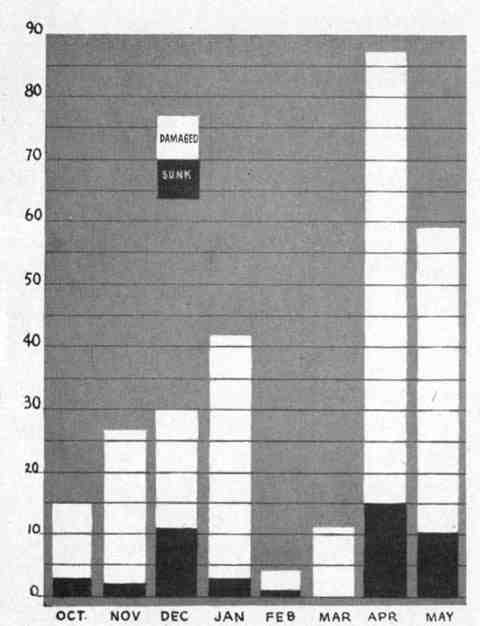
DAMAGE TO SHIPS
Many ships have been hit more than once, the enemy having a penchant for seeking to finish off ships whose defensive strength has been impaired. Thus the number of ships hit (listed below) is somewhat less than the number of hits on ships:
Table IV
| October | 17 | February | 4 |
| November | 26 | March | 11 |
| December | 30 | April† | 87 |
| January | 42 | May† | 59 |
| Total | *115 | Total | *161 |
* Although monthly totals are correct, those for 4-month periods contain duplications as a result of ships being hit in 2 or more months.
† April and May figures are based on dispatches, which frequently classify damaging near misses as hits.
DAMAGE BY SHIP TYPE
During the period February-May the enemy devoted 38 percent of his suicidal effort to destroyers and 45 percent to even smaller types. Following is a tabulation of hits, damaging near misses, nondamaging misses and ships sunk, by ship type, for this period, based entirely on action report data.
--3--
Table V
| Type ship | Hits on ships |
Damaging near misses |
Nondam- aging misses |
Total attacking |
Ships sunk |
|
|---|---|---|---|---|---|---|
| BB | 6 | 2 | 16 | 24 | (5%) | |
| CA | 2 | 2 | 4 | (1%) | ||
| CL | 2 | 5 | 7 | (1%) | ||
| CV | 10 | 4 | 24 | 38 | (7%) | |
| CVL | 3 | 4 | 7 | (1%) | ||
| CVE | 3 | 3 | 3 | 9 | (2%) | 1 |
| DD | 67 | 21 | 105 | 193 | (38%) | 7 |
| DE | 11 | 8 | 23 | 42 | (8%) | |
| Other naval vessels | 59 | 24 | 95 | 178 | (35%) | 8 |
| Merchant | 5 | 3 | 1 | 9 | (2%) | 3 |
| Total | 165 | 68 | 278 | 511 | (100%) | 19 |
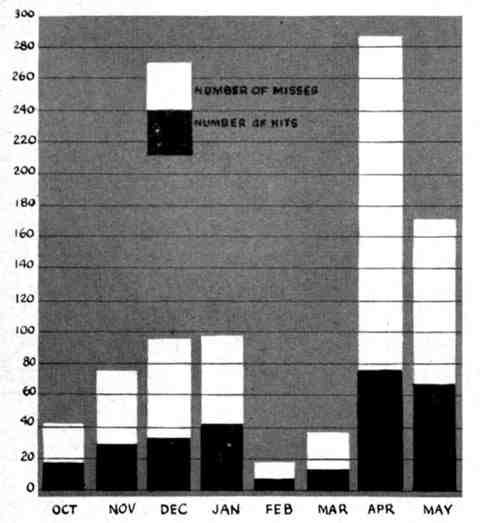
T.F. 58 vs. SUICIDERS
Task Force 58 turned in an excellent performance against suiciders in the period February-April. During this period (most attacks occurred in April) the task force caused 86 percent of all suicide planes to miss their targets, as compared with 52 percent in the period October-January.
The following table shows the record of Task Force 58 as compared with that of other combatant and noncombatant forces during the 3-month period:
| Planes attacking |
Planes hitting |
Planes missing |
Percentage AA. success |
|
|---|---|---|---|---|
| Task Force 58 | 64 | 9 | 55 | 86 |
| Other forces | 276 | 88 | 188 | 68 |
The success of Task Force 58 is attributed to:
1. Better 5-inch performance as a result of (a) releasing batteries for sector control, (b) opening fire at longer ranges, (c) use of high percentage of VT fuzes, and (d) greater availability of firepower, speed, and maneuverability.
2. Improved target acquisition due to coordination of effort by all ships of a task group.
3. Greater attention to intra-ship defense effort, and especially to closer liaison between OIC and gunnery department.
4. Lack of coordinated attacks by large groups of planes.
5. Increased anti-suicide training.
6. Use of destroyer divisions-or squadrons on picket stations.
SUICIDE EFFECTIVENESS
The reason the enemy has concentrated on suicide attacks rather than the conventional methods is revealed clearly in an analysis of the relative effectiveness of suicide and nonsuicide attacks. The following comparison for the period October-April is based on the figures in table I:
Table VI
| Suicide planes |
Nonsuicide planes |
|
|---|---|---|
| 1. Average number attacking per hit on ship | 3.6 | 37 |
| 2. Percentage hitting ships | 27 | 2.7 |
| 3. Enemy losses per hit on ship* | 3.6 | 6.1 |
| 4. Percentage of planes lost to AA. or in suicide crashes | 100 | 17 |
* The enemy lost 784 suicide planes to score 216 hits on ships, and 356 nonsuicide planes to obtain 58 hits. On a basis of this performance, had he devoted the entire effort of the 2,936 planes coming within ship's gun range to suicide attacks, he would have scored about 792 hits on ships as compared with 79 hits had he used nonsuicide attacks exclusively.
--4--
Chapter II
ENEMY TACTICS
Japanese suicide tactics have improved in several respects since their inauguration during the Philippines campaign.
Most important of the enemy changes in tactics are the following:
Highly concentrated attacks on DD radar picket stations.. -
Increased coordination during multiple attacks.
Inauguration of night attacks and increased emphasis on attacks at dawn and dusk.
Use of special suicide equipment, such as the Baka.
In the light of information obtained from ships' descriptions of enemy attacks since the occupation of the Philippines, Japanese suicide tactics are summarized here:
TIME OF ATTACK
The first attacks were made in the daytime exclusively. These attacks were directed chiefly at carrier task groups, and were concentrated around the noon hour when carriers were engaged in launching new strikes or receiving returning planes.
Because attrition as a result of air cover made daytime attacks too costly, the enemy changed to twilight attacks, with emphasis being placed on those at dusk. There were no suicide attacks in the Philippines between 2100 and 0400.
At Iwo Jima in February the only suicide attacks occurred between 1700 and 2000. In March, on the other hand, when attacks occurred in the Kyushu-Okinawa area, nearly all firing at enemy aircraft was done at dawn. However, there were several attacks in the afternoon, and at least six between midnight and 0400.
During the occupation of Okinawa in April approximately 80 percent of the attacks occurred between 1400 and 1900. The other peak period was from 0600 to 0900, and a few raids occurred at noon. In May attacks were made almost exclusively at dawn and dusk. There is a trend toward more night attacks, and an increase in this type may be expected.
DEPARTURE AND RENDEZVOUS
A Japanese Army manual outlining suicide procedures recommends that planes take off in the following order: First the guide planes, then the intermediate escort force, the direct escort force, and finally the suicide force. The rendezvous is carried out with the suicide planes as the nucleus over a point near the airfield of departure. If enemy planes are in the area, the Jap force is advised to take off especially rapidly and fly at extremely low altitude to a rendezvous point.
THE ADVANCE
After the rendezvous, the attack force commander orders the advance. "The route of advance will by all means avoid interception by enemy fighters," according to the Japanese instruction manual, which continues: "At times it will be better to pick detours so as to make a surprise raid on the enemy. While advancing, give due regard to general atmospheric conditions, making every effort to take advantage of local weather conditions, that is, clouds, sun and wind direction. This will be especially true in daylight and surprise attacks.
"In the advance the attack force commander will determine the altitude and speed of the advance with due regard for the performance of the suicide and escort planes. Both forces must guard against any separation at all during the advance. This applies particularly in case of poor weather and atmospheric conditions.
"The formation for the advance will depend on conditions, particularly on the attack method (strong raid, surprise raid, etc.), on the strength used and on the disposition of the enemy. It is particularly advantageous to deceive the enemy
--5--
by adopting formations and maneuvers which resemble those of his carrier-borne aircraft."
The document advocates as a rule of thumb that for "strong" raids a high speed, high altitude approach be made, and that for a "surprise" raid an extremely low altitude approach be made.
THE APPROACH
Because attack groups often are intercepted and broken up before reaching their objectives, and because the enemy frequently lacks aircraft in sufficient quantity and quality to comply with the formal approach doctrines outlined in the Japanese manual, enemy approach tactics as witnessed by our own planes and ships are given here:
Avoiding Interception by CAP--Since the only mission of suicide pilots is to crash into U.S. naval vessels they make every effort to avoid our fighter cover. They fly very high--above 20,000 feet--or very low. Camouflage is designed to make the planes difficult to detect either from above or below. When intercepted by our fighters the formations break up and planes evade independently, making best use of the sun and cloud cover. Cloud cover, especially, makes interception by CAP difficult. When about 10 miles from the ships to be attacked, planes making a high-level approach go into a 20-30 degree power glide. Cloud conditions generally govern the altitude of approach--the higher the clouds the higher the approach. Concealment by flying low over land is a favorite tactic, and the enemy may be expected to take every possible advantage of land masses in the future.
That the enemy's effort to avoid CAP has not been entirely satisfactory has been indicated by his trend toward twilight attacks. In these his tendency is to approach from the direction of the dark horizon. In night attacks the approach usually is with the ship silhouetted against the moon.
Avoiding Radar Detection.--To hamper fighter direction and target acquisition, the enemy has used weaknesses of our search radars to excellent advantage. Many attacks are made from the direction of the nearest land, against which the target is lost on radar screens. During a high-altitude approach enemy planes pass through radar null areas, and during low-level approaches they pass under the radar horizon.
Frequently suiciders trail in the shadow of the IFF (Identification--Friend or Foe) of our planes returning to their bases. In several instances enemy aircraft have been suspected of using IFF code similar to that used by our own aircraft. During twilight and night attacks, "window" or "phantoms" are employed to confuse our radar screens, and have been more effective against our night fighters than our ships.
Surprise is effected occasionally by splitting up into several small groups and approaching from different altitudes and bearings. One or two groups usually are picked up, but another may slip through undetected.
Avoiding Visual Detection.--Besides fighter and radar detection, the enemy seeks to make the visual detection problem difficult. Best use is made of clouds, sun, land background, the dark horizon at dawn and dusk, and other natural phenomena.
The following table indicates the altitudes at which suicide planes first were sighted by ships during the period October-May:
| Altitude | Oct.-Jan. | Feb.-May |
|---|---|---|
| Percent | Percent | |
| Low (less than 500') | 38 | 35 |
| Intermediate (500'-2,999') | 14 | 41 |
| High (3,000' or over) | 48 | 24 |
THE ATTACK RUN
After reaching attack position--effective antiaircraft range--enemy planes continue tactics directed at effecting surprise and, in addition, at complicating the fire control problem.
The most obvious change since the Philippines campaign has been the increase in multiple, coordinated attacks which saturate the AA. defense of ships under attack. This has been especially characteristic of attacks against radar picket stations.
The Japanese Suicide Manual states that "The basis for success in attack line is getting lined up on the target and keeping on it. The suicide force commander and his men will calmly, cleverly, and rapidly, locate their targets, then make a systematic attack run.
"As soon as the attack targets are discovered the pilots will first pull the fuze arming vane release handle and then close the attack on the enemy by diving down on him at full speed, following him like a whirlwind, and countering every move he makes. At this time every effort must be made to avoid losses from the enemy CAP and AA. barrage by appropriate maneuvers.
"The final run-in will differ according to
--6--
conditions, particularly the types of plane, weather, atmospheric conditions, etc.; however either a steep dive or an extreme low altitude final run-in will be used. In all circumstances, however, the right points for beginning the attack run and final run-in must be chosen so as to have the desired momentum at the time of collision.
"The final run-in for a steep-diving attack will differ with the type of plane; however, the approach to the enemy will be at high altitude, then altitude and speed will be successively adjusted (this varies with the situation but it will be best to adjust the speed twice, at 6,700 yards and 4,500 yards). Take into consideration the speed and altitude at the commencement of the final run-in and care must be taken so that the diving angle is neither too steep nor too shallow.
"Although generally the steep diving attack method is employed, precautions must be taken because acceleration during the attack run causes the diving angle and maintenance of speed to be unsatisfactory at the point of beginning and final run-in and thus inability to collide with the ship.
"In the final run-in for a low-level horizontal attack the enemy will be approached at high altitude. Then, by rapid plane maneuvers, while speed and altitude are successively adjusted, arrive at the point for beginning the attack run. Either a diving collision or a horizontal collision attack run will be made. At this time speed will be maintained and the right point for beginning the attack run will be selected. At the time of the collision sufficient colliding power must be maintained.
"Just before the collision, the elevator control must be sufficiently pressed forward to allow for the increase in speed. It is essential at this time not to miss the target because of shutting one's eyes for a moment."
Japanese attack-run tactics as reported by ships include the following:
1. Diving out of the clouds or sun at angles of 20° to 45° from altitudes of 3,000 to 6,000 feet and from ranges of 3,000 to 6,000 yards.
2. Weaving low on the water until within 1,000 yards of ship, then zooming up to 1,500 feet, doing wingover and crashing onto ship's deck or superstructure.
3. Weaving low on the water and continuing torpedo-type run into side of ship or superstructure. (Amphibious and other lightly armored ships are the usual targets of this type of attack.)
4. Attempting to make topside crash from dead astern or dead ahead.
5. A low approach past the bow or stern of the target, then a sharp vertical turn into the target's bridge.
6. Making radical maneuvers in some cases but, as a general rule, evading slightly or not at all. Ships report evasive tactics, usually of a mild sort, in 20 percent of the known cases during the period February-May, as compared with 41 percent in the Philippines.
TYPES OF SHIPS ATTACKED
Carriers and troop transports have been given first priority as targets by Japanese suicide doctrine. As a result of their exposed positions while on picket duty, however, and the difficulty of evading fighters under their control, destroyers have been subject to attack more frequently than any other type of ships during the period February-May.
It should be pointed out that when a carrier was in formation it was almost invariably singled out for attack. Landing craft were taken under attack chiefly when they were attached to picket stations.
When damaged by AA. or harassed by our planes, suiciders selected targets of opportunity. Once hit, a ship was likely to be attacked by other planes seeking to finish it off. The Evans (DD552), for example, was hit by four planes during an attack while on picket duty on 11 May, and the Aaron Ward (DM34) was hit by five on 3 May.
Heavy ships have not been attacked as frequently as in the Philippines campaign. This is probably a result of the enemy's realization that BB's, CA's and CL's are able to defend themselves with greater effectiveness and are less vulnerable to critical damage than lighter ships.
POINT OF AIM
According to Japanese doctrine, "The collision point will vary with the type of plane, kind of target, its size and speed, but in the event of a steep diving collision it will be on the deck, amidships, if possible between the stack and the bridge, and for carriers, at the elevators. In the case of an extreme low altitude horizontal collision, the best point will generally be amidships slightly above the water line."
In many cases the collision point has been the bridge itself. Crashes into the hull have been confined largely to DD's and other lightly armored ships. In attacking aircraft carriers suicide pilots often aim for planes spotted on the deck.
--7--
TYPES OF PLANES USED
The enemy has used all types of planes in his suicide attacks--twin- and single-engined planes, new and obsolete aircraft. The Baka bomb is discussed in detail in chapter V.
Suicide planes for the most part have been Vals and Zekes, carrying one or two 250-kg. bombs. Many obsolete types also were employed against picket stations and transport areas, but against Task Force 58 combat types were used.
Types of planes employed in suicide crashes have included Zeke 52's and 21's, Oscars, Vals, Kates, Tojos, Tonys, Judys (including the radial engine type), Bettys, Franceses, Irvings, Dinahs, Lilys, Jills, Marys, Alfs, Petes, Jakes, Rufes, Hamps, Nates, Sallys, and Nicks.
At Okinawa many obsolete types were employed, usually to supplement attacks by more modern aircraft. During one heavy attack fighter-bombers were followed by float planes which sought to finish off ships already damaged.
ANTICIPATED DEVELOPMENTS
Attacks at night, dawn and dusk may be expected to increase.
During early phases of amphibious operations strong daylight attacks will be made, the enemy being willing to expend large numbers of planes in an effort to make the offensive costly.
Single-engined planes will be used almost exclusively, the enemy converting the Betty, Peggy and Frances for Baka-carrying purposes.
Heavier bomb loads are likely, with planes carrying only sufficient gas for a one-way trip, and explosive in excess of rated capacity.
Continued improvement of coordination is certain to be attempted by the enemy.
Suicide attacks will increase steadily at the expense of conventional forms of attack.
The Japanese are estimated to have 5,000 training-type aircraft (classified and with the characteristics indicated below) all of which will very probably be employed to the maximum extent of their capabilities in suicide attacks.
| Type | Estimated bomb load |
Maximum range |
Maximum speed |
Maximum diving speed |
|---|---|---|---|---|
| Pounds | ||||
| Advanced | 1,100 | 625 | 200 | 275 |
| Utility | 1,760 | 575 | 200 | 250 |
| Klementary | 450 | 400 | 140 | 180 |
The following table gives plane characteristics of combat type aircraft:
| Type | Estimated bomb load |
Maximum range |
Maximum speed |
Maximum diving speed |
|---|---|---|---|---|
| Pounds | ||||
| S.E. fighters | 500 | 1,300 | 380 | 500 |
| T.E. fighters | 1, 100 | 2,000 | 370 | 500 |
| S.E. bombers | 1,100 | 1,900 | 310 | 400 |
| T.E. bombers | 1, 760 | 2,500 | 315 | 400 |
| Float planes | 550 | 1,080 | 245 | 300 |
| Recce | 1,760 | 2,000 | 370 | 500 |
To conserve his air strength for use in suicide attacks against our surface forces, and especially to prevent destruction of his aircraft on the ground, the enemy will make best use of concealment, camouflage, dispersion and deployment.
It is to be anticipated that in the Okinawa campaign the Japs learned they cannot seriously interfere with an amphibious operation by attacking picket stations. In future operations they may be expected to concentrate on troop and cargo transports and large amphibious craft before they have discharged personnel and equipment. Destruction of the enemy "at water's edge," a threat the Japanese heretofore have been unable to accomplish, will be attempted on a large scale in future operations.
Because of the vulnerability of air strips and their facilities to bombing, the enemy is concentrating on the production of float planes for use from Japanese rivers, lakes and harbors. These will be used chiefly at night, as will other suicide planes.
An intensive training program to prepare pilots for night operations is being carried on by the enemy.
ATTACK BY TRAINERS
During an attack on Task Group 95.5 at 0100 on 29 July the Japanese used biplane trainers. They were described as flimsily constructed of wood and fabric.
The action occurred during very bright moonlight, the enemy using several planes simultaneously in coordinated attacks. The Callaghan (DD792) was sunk and the Pritchett (DD5G1) was damaged.
Although the planes were believed to have approached at an altitude of 1,000 feet they were not picked up by any ship until they had closed to 13 miles. The maximum speed at which they were tracked was 90 knots, but they were extremely maneuverable and expertly piloted.
--8--
Use of such training planes in night attacks may be expected to increase. Despite their low speed these trainers represent AA. targets almost as difficult as the fast but less-maneuverable combat planes.
Their type of construction has led to concern as to the effectiveness of our current weapons in countering them. The standard TD2C drone is of full plywood construction, although currently it is doctored by a wire netting to more closely approach the radar reflection characteristics of service planes. In its stripped condition, however, it closely resembles the Japanese trainer.
The stripped TD2C will give a reliable burst radius of 30 feet with Mark 53 fuzes. This represents considerable reduction from the 100-foot burst radius of a service aircraft, but the low speed and greater vulnerability of a trainer should offset this to some extent. The over-all effectiveness of VT on the Japanese trainer should be about equal that on a service aircraft.
The wooden and fabric plane should be very vulnerable to 40-mm. fire. Doped fabric panels are sufficient to activate the standard 40-mm. fuze, and the structural damage of a hit should be great. The 20-mm. fuze will require hits on wing spars, fittings, engine or tanks to be activated.
Radar characteristics of the TD2C should be applicable to those of enemy trainers. The stripped drone gives the following results:
| Type radar | Maximum observed range |
Maximum trackable range |
|---|---|---|
| Yards | Yards | |
| SC | 120,000 | |
| Mark 4 | 22,000 | 18,000 |
| Mark 22 | 12,000 | 12,000 |
1 Over.
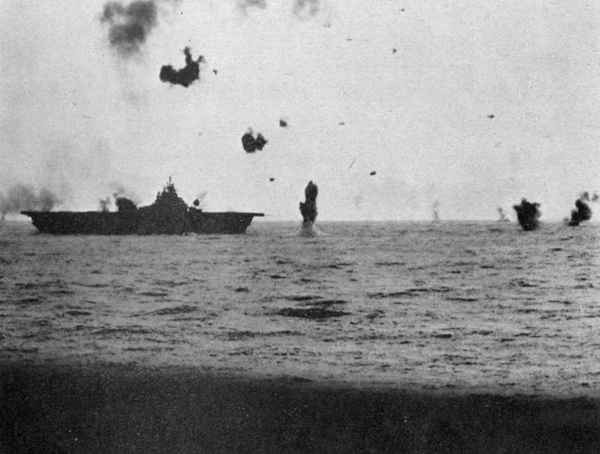
--9--
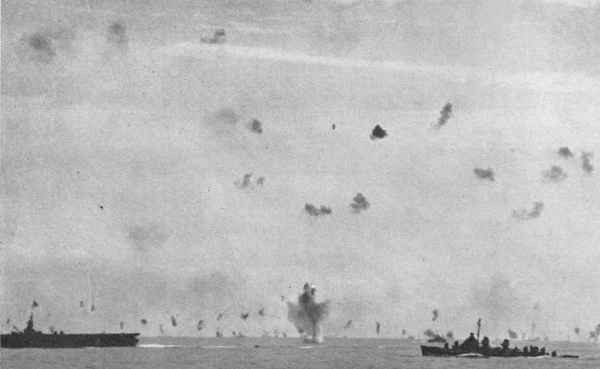
Chapter III
SHIP DEFENSE
The defense of ships against suicide attacks has received the concentrated attention of naval forces afloat and ashore. That the answer has not been developed is revealed by the record of damage suffered by ships during the Okinawa campaign.
However, progress is being made in the form of improved tactics, more efficient use of present equipment and the development of better tactics and equipment. In the fleet, attention has been directed in the following channels: Early warning, air cover and discipline, target acquisition and designation, fire control, dispositions, speed and manuevers, and equipment. In these fields the fleet has done the following:
EARLY WARNING
To reduce the number of surprise attacks, which were characteristic during the Philippine campaign, the establishment of radar picket stations was effected at Okinawa. These stations, whose purpose was to extend the radar coverage of the task force, were located 40 to 60 miles from the transport area.
The functions of the pickets were those of early air warning, fighter direction, and engaging enemy planes with gunfire. Picket stations were manned by DD's equipped for early warning and fighter direction, and by landing craft, which assisted in visual detection, gunfire defense, and lifeguard duties.
Pickets accomplished their purpose in an effective manner, sharply reducing the number of surprise attacks, but they underwent a severe mauling from suicide attacks in the process. The defense of picket stations is discussed in detail in chapter V.
In the Okinawa campaign outlying islands were
--10--
captured and radar stations eventually placed on them. These islands were not captured in the early stages of the campaign, and radar equipment was not available for quick installation and operation.
After the radar installations were made, the need for picket ships near these islands was removed, and it became possible to use the vessels for reinforcing other picket stations. Because of the damage suffered by surface stations the unsinkable shore picket stations, with long range air search and height-finding equipment and personnel, filled a vital need.
In some areas of future operations it may be possible to establish shore-based radar picket stations at some distance from the main beachhead in such numbers that the need for ship pickets will be reduced significantly. The ships released from this duty will be available for close-in protection of forces near the landing areas.
If AEW (Airborne Early Warning) radar operates well (see p. 1 ch. 7), aircraft equipped with it will give early warning of approaching enemy attacks and will permit interception of attacks at greater ranges and thereby give our fighters a longer time to destroy the enemy aircraft before they reach position to attack.
AIR DEFENSE
Carrier aircraft have been employed offensively to diminish Japanese air power by destroying enemy planes on the ground and bombing enemy aircraft production plants and air strips. Carrier strikes, now that air operations are being stepped up from bases on Okinawa and the Marianas, will be increased against air fields on the Japanese mainland.
Fighters have been employed defensively in great numbers, with attention given to stacking and defense in depth. Fighters were assigned to picket stations, which, when under attack, drew on air support from other stations and from a pool of fighters over the transport area.
Air defense has been weakest at dusk and dawn, when it was most needed. Too, it was weak close to land, where ships most required such support. Air cover has destroyed more than 60 percent of the planes en route to attack the fast carrier task force, and only 40 percent of those raiding other surface ships. The twilight air cover problem is discussed in chapter V.
Night attacks have not been a serious problem to date, but they are expected to increase materially during future operations. The F7F (N) is expected to improve night interceptions, and it is hoped that the installation of searchlights on night fighters, now being tested, will facilitate interception.
TARGET ACQUISITION, DESIGNATION
Every effort is being made by the fleet to facilitate early engagement of enemy planes with 5-inch gunfire. To do so necessitates clarification of the close-in picture, which often is confused by the presence of friendly aircraft.
Task groups of the fast carrier task force have developed, and are continuing to improve, AA. Coordination Plans, designed to provide concentrated 5-inch gunfire while guarding at the same time against further undetected attacks.
This plan calls for a task group AA. coordinator, through whom all target information filters to and from ships over a special VHF circuit. The task group is divided into four sectors, and ships in each sector, when alerted, supplement search radars with fire control radars. The plan imposes no restrictions of freedom of action by individual ships in repelling air attacks.
Although this plan has been described by ships' commanding officers and by task group commanders as highly successful, the AA. coordinator should insure against individual ships being so complacent as to depend upon him alone for target information.
Adaptations of coordination plans might well be developed for use by task groups other than those comprising the fast carrier task force.
Other steps being taken by the fleet to improve target acquisition and designation include:
--11--
1. Stressing the function of CIC to give greater attention to the close-in problem--detecting targets and designating them to fire control radars. Ships are emphasizing the importance of the duties of the gunnery liaison officer in CIC, and are selecting experienced gunnery officers for the post. (See Chapter 6, USF 10B; Rad 6 and Rad 1A.)
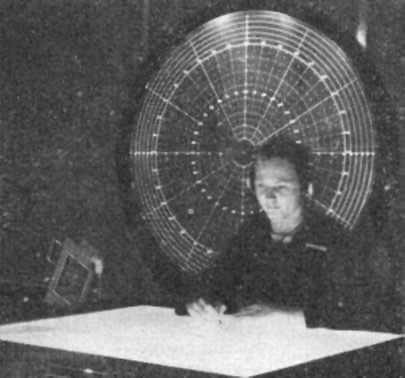
2. Impressing lookouts and gunnery personnel with the necessity for alertness and prompt recognition of enemy planes. Training emphasizes that a plane making a threatening approach is enemy until definitely identified as otherwise.
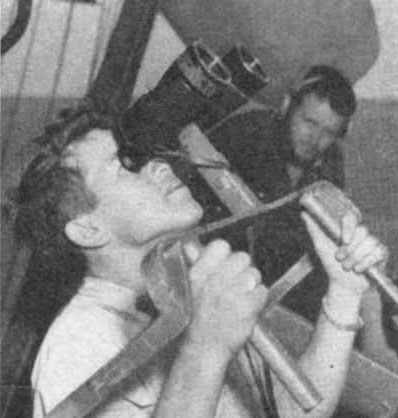
3. Pointing out an enemy plane to other ships and CAP by filing a 5-inch burst or automatic weapons in its direction before it comes within effective range.
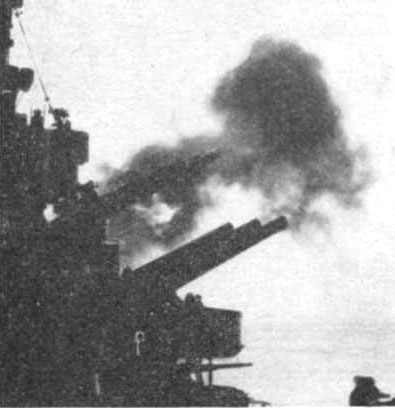
4. Briefing pilots on the importance of using individual initiative in the detection of enemy planes without aid from the FDO. Pilots also are being warned to search their own returning strikes to detect enemy planes approaching ships in the shadow of friendly IFF, and to notify ships of the location and extent of success of their interceptions, reporting every plane getting through melee.
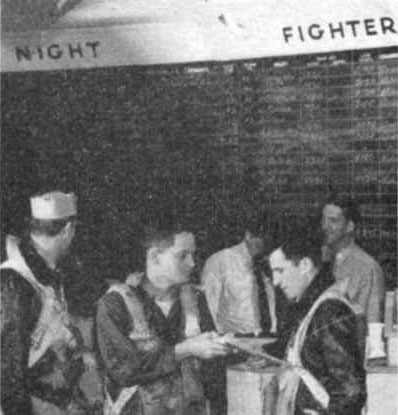
5. Establishing sectors and procedures for the approach of returning strikes to permit ships to open fire on all planes not following the prescribed procedures.
6. Assigning to outlying surface picket stations the duty of conducting visual inspection of each returning strike to detect and destroy trailing enemy aircraft.
--12--
ANTIAIRCRAFT DEFENSE
During the Philippines campaign AA. defense was not as strong as it might have been. This was attributed chiefly to the surprise nature of many attacks and to the failure of 5-inch batteries to open fire at long range. (The average open-fire range was 4,400 yards for all ships.) At Okinawa there were fewer surprise attacks and, as a result, 5-inch performance showed considerable improvement.
Doctrine in the fleet for AA. actions against air attack now calls for early and heavy 5-inch fire, using a high percentage of VT-fuzed projectiles, tight dispositions, high speed, and maneuvering to place target on beam.
Specific operating practices employed by many ships include:
1. Opening 5-inch fire at 10,000 to 12,000 yards without waiting for perfect solution.
2. Using small, manually-operated, lead-computing directors, such as Mark 51, 52 and 57, in control of 5-inch batteries against surprise attack. If a target is picked up at long range control is shifted to the main director. Many ships find that they can get 5-inch guns in action against close-in targets by this method faster than with the Mark 37 director. The effect of blast and smoke on the operation of small directors is the chief complaint against this system. To reduce this effect some ships tie in several 5-inch and 40-mm. mounts to those auxiliary directors which are least affected by smoke and blast. Considerable difference of opinion exists in the fleet with respect to the advisability of controlling the 5-inch battery with auxiliary directors. Preliminary tests conducted by Task Force 69 (see ch. VI) indicate that a well-trained crew on a Mark 37 director, in good adjustment, also can make hits quickly. The choice of method to use may depend upon the state of training and upkeep of the various types of directors available for the control of the battery.
3. Using as many directors as are available for each target, employing full rate control, radar ranges, and optical pointing and training if visibility permits.
4. Setting target speed on computers at 350 knots or greater so that solution rate controls
down to meet the target speed and avoids trailing behind.
5. Adjusting 40-mm. batteries for maximum cyclical rate of fire (160 rounds per minute.) Mark 63 and Mark 57 control of 40-mm. batteries has been provided for some ships. Radar range inputs provided considerably improve the accuracy of 40-mm batteries.
6. Employing strict fire control discipline to avoid firing into own ships or shooting down friendly planes.
7. Holding 20-mm. fire until target reaches 1,500 yards to prevent exhausting the magazine of ammunition when the plane reaches critical range. Holding 20-mm. fire also will reduce smoke.
8. Using every available occasion for training in recognition, firing at drones and sleeves, dry tracking, target acquisition, ammunition supply, etc.
CONCEALMENT
Although aggressive use of firepower is normally the best means of defense, the value of concealment is not disregarded in some situations. Amphibious ships and transports, which lack radar fire control equipment, have employed smoke from dusk to dawn over anchorages, stressing its use at twilight. Smoke has proved effective, the enemy confining his night attacks to ships on patrol outside the blanketed area. It is possible however that, in the future, suicide planes will fly low through smoke screens to crash whatever ship is in their path.
The fast carrier task force, on the other hand, having radar fire control equipment and boasting high speeds and maneuverability, rarely has occasion to use smoke. Airborne oil fog is going into production.
When on ASW patrol outside transport areas ships steam into or away from the moon to present the minimum silhouette, and make use of concealment provided by cloud shadows and the dark side of land.
PROPOSALS FOR DEFENSE
Scores of suggestions for suicide counter-measures have been made from the fleet and other sources. Typical proposals are discussed here:
--13--
EARLY WARNING
1. Recommendations have been made for the early establishment of adequate shore-based picket stations, equipped with air warning and height-finding radars and properly coordinated ADCC's (shore-based CIC's). These early stations should be supplanted by permanent long range equipment as soon as the tactical situation permits.
In case such installations are established, task force and group commanders should be informed regularly of the status and capabilities of shore-based radars so they can dispose their own picket stations to best advantage. Every effort should be made to coordinate shore-based and shipboard radars. A control organization and doctrine is outlined in Chapter 6, USF 10B.
Also on land, visual lookout stations should be set up on high ground as soon as possible after a beachhead is established. These should be in communication with the warning net as soon as possible.
2. It has been suggested that submarines be used as radar pickets.
The value of having as radar pickets those ships which are inconspicuous, and less attractive targets for siuciders than DD's, is readily apparent. Since targets for submarines are becoming progressively more scarce, a project has been initiated to equip submarines as radar pickets and fighter direction ships.
3. The need for aircraft equipped for early air warning has been pointed out by the fleet.
Such a project is under development at high priority and the first units should reach the fleet in October. AEW is expected to extend the range of radar coverage and increase the efficiency of CAP.
TARGET ACQUISITION
1. Many ships have stressed the need for IFF interrogators for fire control radars.
Technical difficulties have delayed the development of this project, and no immediate solution is available. The Mark 32 interrogator with the Mark 12 fire control radar shows most promise.
ANTIAIRCRAFT DEFENSE
1. Rockets have been proposed as an AA. weapon by many ships.
A project to investigate the feasibility of using rockets against suiciders is being conducted, and a rocket VT fuze is under development. When AA. rocket ammunition is available, it will be sent to forward areas for use in ships equipped with rocket launchers if such use is desired.
2. Strengthening of the 40-mm. battery at the expense of the 20-mm. is frequently recommended.
A policy has been adopted of replacing 20-mm. batteries with 40-mm. mounts in positions where this is possible, and replacing 20-mm. singles with 20-mm. twins where possible and where not possible to install 40-mm. mounts. To increase 40-mm. firepower on DD's, torpedo tubes are being removed.
DISPOSITIONS
1. Cruising disposition, in the form of a block letter "I", for fire support groups has been recommended. The reinforced ends prevent a plane from enfilading and permit maneuvering in formation and a strong concentration of gunfire. Ships in the column steam in open order, 50 yards to right and left of the axis.
CRUISING DISPOSITION
6-VT
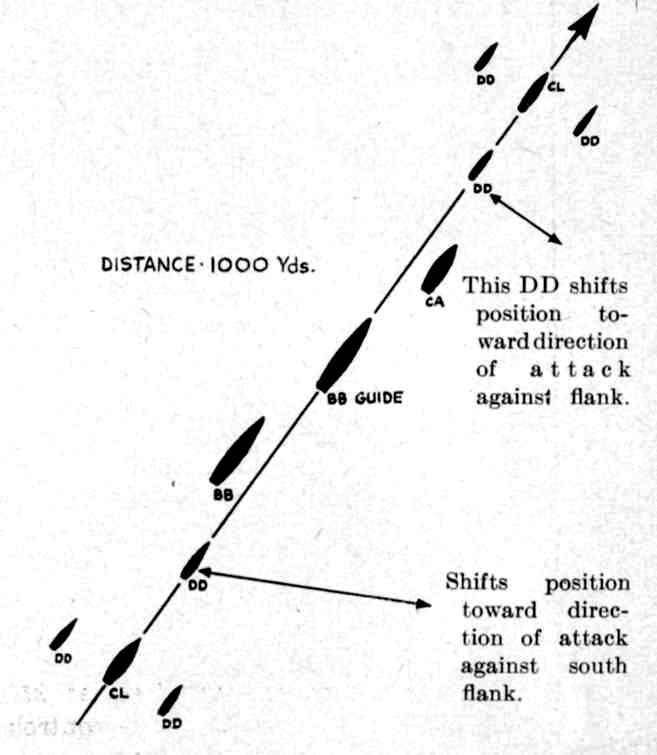
--14--
SUBTERFUGES
1. "Q" ships and decoys to serve as targets for suicide attack have been proposed. The "Q" ship would be heavily armed with AA. batteries and would have the appearance of a carrier or a lightly armed ship, and would present a tempting target to the Kamikazis.
The difficulty involved in the use of "Q" ships is the lack of assurance that even a well-trained, heavily armed AA. ship would be capable of shooting down every attacking aircraft. To be effective long, its performance would have to be perfect. If it steamed by itself, it probably would be sunk soon. If it were in a task group it would, of course, increase the overall gun power of the group.
2. Decoys have been used effectively. These unmanned, defenseless hulks appear as attractive targets for enemy pilots. Their use may cause the enemy to waste considerable effort on worthless targets before the decoys are sunk. One such decoy, the former Barry (APD29), was hit by a suicide plane 20 miles off Okinawa at 1900 on 21 June while being towed to its assigned position. The hulk, equipped with .50-caliber machine guns and smoke pots capable of being controlled remotely by radio, sank at 0300 the next day as a result of damage caused by burning fuel oil.
3. To attract enemy aircraft away from ships after dark a burning drum of oil, perhaps jettisoned by a PT boat at a spot in the water away from the anchorage, has been suggested. An even better decoy is a burning enemy plane. Even if the fires do not inspire attacks, they may be of value in destroying temporarily an enemy pilot's night vision.
MISCELLANEOUS
1. Barrage balloons as a passive defense of anchorages have been requested.
Balloons were used in considerable numbers and with some success in the Solomons and the Mediterranean. It is possible that they would disrupt suicide attacks and cause the destruction of some planes. However, they interfere with air and AA. defense, and serve as designators for enemy shore batteries, particularly off assault beaches, and for enemy aircraft when they protrude above smoke blankets. The Japanese are employing balloons in increased numbers as a defense against low-level attacks and to create a mental hazard for our pilots.
EFFECT OF SHIP MANEUVERS
A statistical study of operational data has been conducted to determine the effect of ships' maneuvers and certain enemy tactics on the success of suicide planes. Conclusions are preliminary and should not be construed as doctrine.
Out of 474 attacks considered, 170, or 36 percent, resulted in hits. Twenty-seven ships were sunk.
The analysis indicates that battleships, cruisers and carriers should employ radical maneuvers when attacked by a suicide plane, the percentage of suicide hits on these ships being much smaller . when they maneuver than when they do not.
The analysis also suggests that destroyers and smaller units should not maneuver radically because they receive a higher percentage of hits when they do. This may be due, in part, to separation during maneuvers, which causes loss of gunfire support from other ships.
The reason large fleet units should maneuver and smaller ones should not apparently lies in the effect of radical maneuvers on AA. effectiveness-AA. effectiveness is practically unhampered by maneuvers of large ships, but is disturbed in the case of the smaller ships, which best can defend themselves by avoiding the roll and pitch resulting from radical turns.
Table I contains data pertinent to the analysis of the effect of ships maneuvers on suicide success. Section A indicates that heavy ships should employ radical maneuvers when under direct attack. Section B indicates that the AA. effectiveness of small ships declines sharply when they maneuver radically.
Table I
| BB, CA, CL |
CV | CVL, CVE |
DD, APD, DM, DMS |
LSM, LST, LSV |
All ships |
|
|---|---|---|---|---|---|---|
| Section A--Percentage Success by Suicide Planes | ||||||
| Maneuvering ships. | 0 | 42 | 0 | 37 | 33 | 34 |
| Nonmaneuvering ships | 87 | 70 | 30 | 22 | 19 | 31 |
| Section B--Percentage of Suicide Kills by AA. | ||||||
| Maneuvering ships | 70 | 83 | 71 | 59 | 67 | 62 |
| Nonmaneuvering ships | 71 | 80 | 74 | 76 | 51 | 68 |
--15--
The study indicates that the beam is not always the safest aspect to present to an attacking plane, even though it means heaviest firepower. For a plane making a low approach the consideration of target dimension argues that the beam may be a dangerous aspect to present.
The enemy's range errors in missing ships have been about twice as large as his deflection errors. In order to take advantage of this error distribution it is indicated that the ships should place the beam across the track of a plane making a high-angle dive. Since range errors cannot be taken advantage of in the case of a low-flying plane, it seems better to take advantage of deflection errors by turning the beam away from the plane's course. These data are based on relatively few incidents and are presented only as an indication of the situation. Ships are convinced from operational experience that no maneuvers should be made which reduce gun defense.
Table II shows the percentage of suicide attack successes on a basis of angle and bearing of approach. By considering the effect of the suicider's relative bearing of approach upon his success, some notion may be had as to what maneuvers should be employed by the vessel under attack.
Table II.--SUICIDE SUCCESS
| High-angle approach |
Number cases |
Low-angle approach |
Number cases |
|
|---|---|---|---|---|
| Percent | Percent | |||
| Ahead | 100 | 1 | 36 | 11 |
| Bow | 50 | 6 | 41 | 17 |
| Beam | 20 | 10 | 57 | 23 |
| Quarter | 38 | 13 | 23 | 13 |
| Astern | 80 | 6 | 39 | 23 |
Also revealed by the study are:
1. Suicide attacks made at high plane speed are considerably more successful than those at low speeds.
2. The percentage of hits scored by planes making nonevasive runs is greater than by those engaging in evasive tactics.
3. A higher percentage of hits was scored by planes making low-angle approaches than by those making dives.
4. Suicide planes, for best results, should make a low, fast approach from the target ship's beam. When those optimum tactics were employed 47% of the planes hit their targets. When tactics other than the optimum were used only 35% of the planes hit their targets.
On the basis of data included in this study the following is concluded:
1. All ships should attempt to present their beams to high-angle approaches, and to turn their beams away from low-angle attacks.
2. Battleships, cruisers, and carriers should employ radical changes of course in order to present the proper aspect.
3. Destroyers and smaller fleet units and all auxiliaries should turn at high speed to present the proper aspect to the attacking plane, but should not turn so sharply as to affect the accuracy of their AA. fire.
The importance of employing these optimum tactics is illustrated by the fact that only 29% of attacks on ships using these tactics were successful, and 47% of the attacks were successful on ships using other than these tactics.
This report does not take into account the fact that a hit along the axis of the ship is likely to cause considerably more damage than a hit from the beam. A plane hitting topside in a beam attack may skid across the deck and into the sea, but one hitting in an attack from astern, for example, is more likely to slither up the deck, causing considerable damage and remaining on board.

--16--
Chapter IV
AIR DEFENSE
It is doctrine to vector out the nearest CAP division at once when a bogey comes within 100 miles, in an attempt to make interception as far out as possible. A detailed analysis of raids against fast carrier task groups from 25 October 1944 through February 1945, confirms the fact that this policy is very important, and shows some of the reasons for its advantages, even when only a small number of fighters can be sent out against the enemy.
The two essential factors contributing to the advantage of early interception are:
The CAP making the initial interception shoots down a high proportion of the planes in the enemy group--about 60 percent--even when greatly out numbered, but the percentage splashed does not rise appreciably as the ratio of interceptors to raiders is increased.
Enemy planes escaping from an engagement with the CAP have, by dispersing, only a slight chance of reaching the force when interception is accomplished at a range of 50 miles or greater, but their chance of reaching the target increases very rapidly with shorter ranges of breakaway from interceptions.
These two factors combine to produce the results tabulated below. For raids which are engaged, the percentage of the enemy planes which survives or escapes combat and manages to reach the task group is given for a series of relative numerical strengths of intercepting CAP, and enemy group, and for a series of ranges from the target disposition at which interception is made.
The rather low values of all the entries is noteworthy. At the most unfavorable extreme, only 50 percent of the planes of a raid intercepted by but a quarter of their number of CAP fighters 10 miles from the task group, remain as potential attackers. With interception at 50 miles, and the same numerical superiority, the enemy is able to put only 2 percent of its aircraft over our ships.
The raids during the period covered consisted of from three to 18 Japanese naval aircraft, bombers and fighters which, irrespective of type, all seem to have been potential suiciders. The formations flown were hard to tallyho because of their small size--averaging eight planes per group--comparatively high speed, use of cloud cover, coordination with other raids, and occasional employment of deceptive measures. In some cases tallyho was never accomplished, and aircraft of groups not tallyhoed at all accounted for more than half of the raiders appearing over fast carrier task groups. But when interception was made, the results were very unfavorable for the enemy, as the above table shows.
In most of the actions many CAP divisions would be vectored out, but only a few would engage the incoming raid because it would break up at the first tallyho, the individual bandits diving to the deck or into nearby clouds. The majority would be engaged by the CAP on the spot and, offering little or no resistance, would quickly be splashed. The remainder, however, would make their escape in the meantime.
Larger groups of interceptors destroyed few more suiciders than smaller forces of CAP because the first element to tallyho--a section or a division--would disperse the raid and leave only scattered singles for the other fighters in the vicinity to go after. The relation between the percentage of the enemy group splashed in the initial encounter, and the relative numerical strengths of the CAP and enemy groups, is shown by figure 1. The plotted points represent a
PERCENTAGE OF RAIDERS INTERCEPTED WHICH REACH TASK GROUP
| Range of interception | RATIO--INTERCEPTING CAP TO ENEMY A/C |
||||
| 1:4 | 1:3 | 1:2 | 1:1 | 2:1 | |
| Percent | Percent | Percent | Percent | Percent | |
| 10 miles | 50 | 45 | 38 | 26 | 12 |
| 20 miles | 31 | 28 | 24 | 16 | 8 |
| 30 miles | 15 | 15 | 11 | 8 | 3 |
| 40 miles | 6 | 5 | 5 | 3 | 1 |
| 50 miles | 2 | 2 | 1 | 1 | |
--17--
grouping of the operational data into three categories according to the number of CAP planes in the immediate vicinity of the engagement relative to the number of planes in the raid. The less certain portions of the curve are shown dotted.
Although there is some advantage to be gained by the intercepting group being more than numerically equal to the raid, it is clear that, if it is at the expense of missing additional opportunities to intercept later, the over-all efficiency is reduced. In this connection, it should be pointed out that our own losses in combat have been extremely low, and apparently independent of the ratio of intercepting planes to enemy planes.
The bandits escaping from encounters with the CAP presumably attempt to continue on in to their target to carry out their suicide assignment. Their chance of reaching the force, however, depends very markedly upon the distance they have to cover. Few succeed in reaching the disposition from a range of 50 miles, while a majority get in when the range is 20-25 miles. Some of these straggling suiciders are shot down on the way by backstop divisions of CAP, but their principal obstacle seems to be the problem of navigation. For these raiders, figure 2 shows how the percentage that manage to arrive at least over the DD screen depends upon the range at which interception was initially made. The plotted points represent a lumping of the operational data into three spans of range of interception, and the less certain portions of the curve are shown dotted. The average range of interception was 35 miles.
The curve begins to rise sharply from 40 to 30 miles, ranges at which Japanese airborne search radars begin to become effective and at which visual sighting of large fleet units begins to be possible.
DAY USE OF VFN DURING REDUCED VISIBILITY
Cloud cover acts much to the advantage of the suicide pilot in that it permits him to evade interception by our CAP and during his final approach complicates the fire control problem of recognition and optical tracking.
The employment of night fighters for CAP on days of reduced visibility, when enemy air attacks are probable, may enhance the chance of intercepting planes concealed by clouds or low visibility. The preceding study of CAP effectiveness places emphasis on the importance of effecting interceptions as far out as possible. Continuous pursuit of enemy aircraft through the clouds should reduce the time of consummating the interception.
Night fighter pilots are particularly well trained for this type of work. Day cloud flying is included in the early stage of their instrument flight training and, in the advanced stages, they are required to make interceptions at night in good or bad weather through the use of radar. In effect, the use of VF(N) for CAP on cloudy days may deny the use of clouds as hiding places for the Japs.
The small groups of planes in the skillfully flown suicide raids on fast carrier forces usually have taken advantage of clouds when the cover was
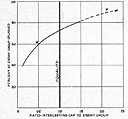
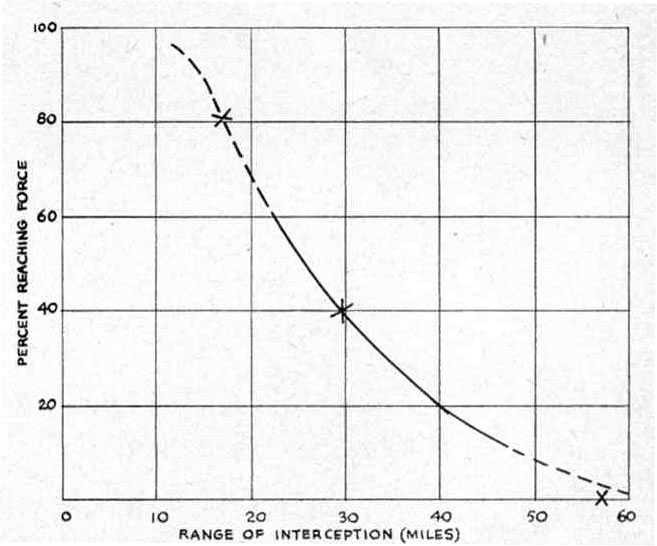
--18--
five-tenths or more and the layer several thousand feet thick.
Planes of such groups not tallyhoed at all accounted for more than half the raiders penetrating to the force, and the use of cloud cover was probably the chief contributing factor in the failure to intercept these untallyhoed groups.
About 60 percent of the planes in raids which were engaged by CAP were splashed in the initial encounter. It is estimated that approximately 80 percent of the 40 percent escaping disappeared into the ever-present nearby clouds before they could be engaged.
The fraction of these escaping aircraft which continued on to the target ships accounted for the other half of the total number or raiders reaching the force.
Cloud cover has on many occasions allowed small groups to orbit unseen in the immediate vicinity of surface forces for considerable time after the radar track had been lost in close-in clutter on the radar scope, and to make their eventual attack a surprise.
The single raiders which have appeared on bombing and suicide missions have taken advantage of only thin cloud cover.
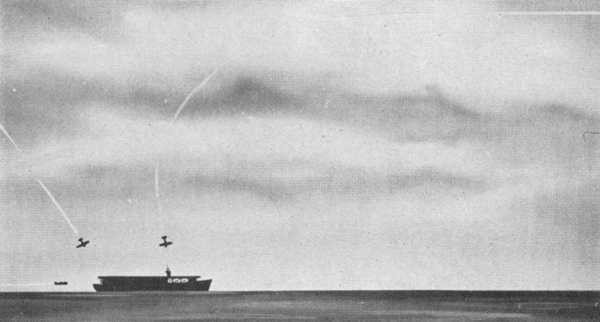
--19--
Chapter V
SPECIAL DEFENSE PROBLEMS
Although many defense problems have been created for our surface forces by the Japanese use of aircraft suicide tactics, four appear to be outstanding and in need of early attention. They are:
1. Defense of picket stations.
2. Defense of ships at night (especially moonlight).
3. Defense of ships at dusk and dawn.
4. Defense against Baka.
These will be considered separately.
Most probable targets in future operations will be APA's, AKA's and large amphibious craft, which the enemy will attempt to destroy "at the water's edge."
DEFENSE OF PICKET STATIONS
(For a discussion of radar pickets' experience see CominCh Secret Information Bulletin No. 23.)
During the Okinawa operation 15 isolated picket stations were established, some only 350 miles from the coast of Japan. Because of their isolation, comparative lack of fire power, and because they were controlling CAP, they were natural targets for suicide planes.
As a result of their early radar reporting, fighter direction at an extended distance from the transport area, and engagement of enemy aircraft with gunfire, the pickets have saved surface forces at assault beaches from more severe air attacks. In the process, however, they have taken a severe mauling from suicide planes.
Better defense of picket stations will be valuable not only for its own sake, but also because it will mean that fewer attacks get through to the transport area. Such improvement can come through increasing picket air cover, fire power, fire control accuracy, earlier and more accurate radar detection and identification, and the establishment of supplementing shore-based radar.
The defense of a radar picket station is identical to the defense of any detached surface unit. It is necessary that the unit on picket station have the ability to:
1. Detect enemy raids.
2.Intercept successfully several simultaneous raids with CAP.
3 Track enemy aircraft from the time they are picked up until they are splashed.
4. Take several raids under heavy gun fire simultaneously and shoot down the attacking planes before they arrive at their targets.
5. Be under the command of one officer.
6. Be capable of maneuvering as a unit or maneuvering in such a manner that the individual components of the picket station can support one another effectively during multiple attacks.
Picket experience at Okinawa indicated that a single destroyer can track and intercept successfully not more than two raids simultaneously. A single destroyer can use its guns successfully against only one raid. If two raids occur simultaneously against a single destroyer, the DD has a choice of dividing its battery and putting up a weak defense against each raid, or keeping its battery concentrated and attempting to shoot down one attacking plane before taking the other attacking plane under fire with its 5-inch battery.
Neither method is satisfactory. In order to have a sufficient volume of 5-inch fire to give a reasonable chance of success against an attacking plane, a battery of not less than four guns is desirable. Consequently, one destroyer cannot be expected to defend itself successfully against more than one attacking enemy aircraft at a time.
As a result of experience, picket stations which were most subject to attack were filled with two or more destroyers and LCS's. This considerably improved the situation. The senior captain was in command of the picket station. He was required to maneuver his own ship and also to maneuver the picket station unit. The ships were usually of different divisions, frequently different squadrons. They had neither worked
--20--
nor trained, together. Consequently, their coordination was not as good as that to be expected of ships which have been operating together as a division under their division commander.
Destroyers are operated very much like fighter planes. A fighter team is formed and trained as a unit. Its success is determined by its ability as a unit, rather than the ability of the individual components of the unit. Destroyers have many of the capabilities and limitations of fighter aircraft. If the tactical situation permits, they deserve the increased defensive power available to them when they are operating as a division under the command of the man who trains them, their division commander.
The fast carrier task groups have had very few successful attacks made against their pickets. If a picket station were put out, not less than a division, and usually a squadron, was placed on the picket station under the command of its regular unit commander. During the entire Okinawa campaign, the fast carrier radar picket group destroyed 86 aircraft by CAP, and shot down 27 by antiaircraft. The picket station was frequently under heavy and persistent attack, particularly in the early part of the campaign. However, only two destroyers were damaged on this duty, and none was sunk. During the latter part of the campaign, enemy aircraft avoided the picket station if possible, apparently realizing it was not profitable for them to attack this efficient little force.
In addition to the mutual gun defense provided by the operation of the destroyer division as a unit, the increased number of ships will permit more satisfactory fighter direction and a corresponding increase in the number of interceptions and a reduction in the effect of casualties to a single ship's communication system.
The increased communication and radar equipment in radar destroyers will enable them to perform this important mission more effectively. It is expected that the addition of Mark 32 radars will enable all destroyers to determine more quickly the enemy character of attacking planes. The replacement of their torpedo tubes with antiaircraft armament will increase their defensive powers.
It is expected that AEW will be in operation in the fleet some time in October, on a limited scale. This should extend the effective range of search radar and in particular give better distance performance against low flying aircraft. The use of an AEW-equipped unit in the picket line, if otherwise tactically feasible, would further extend the radar search coverage and increase the range and efficiency of the picket CAP.
Air Cover.--Not less than one division of fighter aircraft, and preferably more, should be maintained over each picket station and each detached unit under the control of the station during daylight hours.
Provision should be made for rapidly supplementing CAP over each picket station when an attack is probable, so that not less than two divisions of fighters will be under the control of each picket station attacked by the time the attack develops.
When insufficient fighter aircraft are available to meet the minimum specified, picket stations should be consolidated so that such coverage is possible.
Shore-based day and night fighter aircraft squadrons should be established at the first possible hour so as to (a) provide means to supplement CAP rapidly, (b) relieve supporting carriers as soon as practicable, and (c) provide VF(N) in strength to relieve day CAP on station prior to dusk so that at that critical time ships will not be without airborne defense.
Stations should be occupied by fighter-director ships so far as is practicable, and to the extent required to control the increased CAP which will be present when an attack occurs.
Proposals that PT boats and submarines serve as radar pickets have been made, and are under consideration.
In addition, DE's and merchant ships have been recommended for radar picket duty, and seven DE's now are being converted to supplement DD pickets. Authorized AA. armament includes three 3"/50 mounts with Mark 52 directors, a 40-mm. centerline quad aft with Mark 63 director, two 40-mm. twrins and ten 20-mm. singles.
Merchant ship hulls could be stripped down, heavily armed and equipped with CIC, search radar and fighter-director equipment. A ship of this type can be ballasted to present a low freeboard. It could be used, if not required for cargo-hauling, as a single-purpose picket ship, with emphasis on fire power and facilities for fighter-director work around fleet anchorages and beachheads and with slow convoys.
Firepower.--Concentrated gunfire by picket stations has been limited chiefly by the small number of ships present. First stations established consisted of one or two DD's and four landing craft, usually LCS(L)'s.
--21--
To increase its firepower, not less than one destroyer division, under the command of its regular division commander, should be assigned to each picket station.
In the event there are too few DD's available for a division at each station, stations should be consolidated so that the minimum requirement can be met providing the tactical situation permits.
Attention should be given to forming the tightest possible disposition consistent with safe maneuvering, so that ships can bring maximum possible gunfire to bear on all attacking planes in mutual support.
The firepower of picket DD's is being increased and improved by alterations which have been underway for several months. These changes involve removal of torpedoes, torpedo tubes and control equipment, and strengthening the 40-mm. battery to the extent weight and space limitations permit. Mark 63 director systems are being installed to control 40-mm. guns, and 20-mm. singles are being replaced by 20-mm. twins where it is possible and where the installation of 40-mm. mounts is not possible.
Pickets have been instructed to open 5-inch fire at all targets which approach within maximum effective range. VT fuze allowance for 5-inch battery ships has been increased to 150 rounds per barrel. This allowance should be especially helpful to DD pickets.
DEFENSE AT TWILIGHT AND NIGHT
Since the Philippines campaign the enemy sharply increased the percentage of attacks at dusk and dawn. Twilight attacks were more advantageous to the suiciders because:
1. Air cover was not as large.
2. AA. fire was not as effective.
3. Visual detection was poor.
4. Personnel fatigue was greatest at dusk.
Many ships, realizing their vulnerability during periods of poor visibility, have requested that air cover be doubled at dusk and dawn. Of necessity, CAP has had to be reduced sharply at the very period it most was needed.
This reduction was necessary because of the operational losses occurring when day aircraft are landed aboard a carrier during darkness.
Past experience has many times proved the inadvisability of employing CV air groups in operations which result in night carrier landings, and predawn launches must be restricted to relatively small numbers. The CV(N) cannot effectively handle more than 12 VF(N) aircraft during launching or landing operation. Night carrier operations should be limited to VF(N) and VT(N) types. The same restrictions do not prevent operation of day planes from a land strip at night, so dawn and dusk patrols should be provided from shore-based aircraft if they are available.
Fullest practicable use should be made of the offensive potentialities of night aircraft against possible aircraft bases. Economical numbers of VT(N) aircraft can cover a large number of airfields and not only deny the use of these fields to the enemy during the hours of darkness, but interfere with enemy preparation for air operations the following day. VF(N) should be employed as practicable over the target area to fill in those periods in the evening, between departure of the day groups and darkness and in the morning from dawn until the first day fighter sweep arrives.
Dusk, dawn, and night air cover best can be provided from land-based air strips. Such air strips always are high on the priority list of objectives to be captured and developed, but often there is considerable delay, after capture, before these strips are operational.
DEFENSE AGAINST BAKA
Although the Baka, rocket-powered, piloted suicide bomb, was not employed extensively against our shipping during the Okinawa operation, an increase in its use may be expected in succeeding operations.
Of 10 attacks on surface vessels in April and May, 3 resulted in hits, 1 in a damaging near miss, and 6 in nondamaging misses.
It was anticipated that the Japanese, after they were successful in producing suicide pilots in unlimited numbers, would lose no time in developing for their use a more effective weapon than the conventional aircraft. The Baka, first such weapon, presents the most difficult target our surface forces and aircraft have encountered in the war to date. It is also potentially the most dangerous antishipping weapon to be devised, being a guided missile with the best possible control--a human being.
Carried to launching position under the belly of a Betty or other twin-engined plane, the Baka has a range of approximately two miles per 1,000 feet altitude of release. Fifty-five miles is the
--22--
p>maximum horizontal range when released at an altitude of 27,100 feet. The Japanese consider 23,000 feet to be the ideal release altitude, according to a POW. The Baka primarily is a glider, as its rockets are good for only 3 miles.
Assuming a rocket thrust of 800-kg. and a minimum glide angle of 5° 35', the Baka has a maximum impact speed of 525 m.p.h. in a horizontal approach and 618 m.p.h. in a glide angle of 45°. The speed increases 25 m.p.h. for each 5° increase in glide angle.
VF vs. Baka.--The function of fighters as a defense against the Baka is that of destroying the parent plane or causing it to jettison the weapon out of range of the nearest surface, forces. Fighters of Task Force 58 destroyed 32 Baka-carrying Bettys on 21 March.
Because the rockets powering the Baka have a combined burning time of 24 seconds it is likely that the suicide pilot will glide as far as possible before igniting a rocket. During the gliding period the, Baka will be within fighter speeds and therefore vulnerable to VF attack. If attacked at extreme range, the Baka may be forced either to exhaust its rockets before reaching its target or to so decrease its power that its impact speed will be greatly reduced.
It should be pointed out, however, that the parent plane will attempt to approach as close as possible to the ships before releasing the Baka. For this reason, friendly fighter pilots should give first priority to twin-engined planes, most of which will be actual or potential parent planes.
AA. vs. Baka.--From the point of view of antiaircraft, the Baka is a difficult problem because:
1. It is considerably faster than the best conventional Japanese plane.
2. It is subject to marked accelerations as its rockets are activated.
3. It is half the size of a conventional fighter.
4. It has no engine, propeller or gas tanks, all vulnerable parts of a standard aircraft.
The speed of the Baka sharply decreases the firing time of AA. batteries. At a gliding speed of 300 m.p.h. and rocket speed of 550 m.p.h., an approaching Baka would be within firing range of various weapons for periods as follows:
5"/38--53 seconds (10,000 yards in).
40-mm.--13 seconds (3,500 yards in).
20-mm.--5.5 seconds (1,500 yards in).
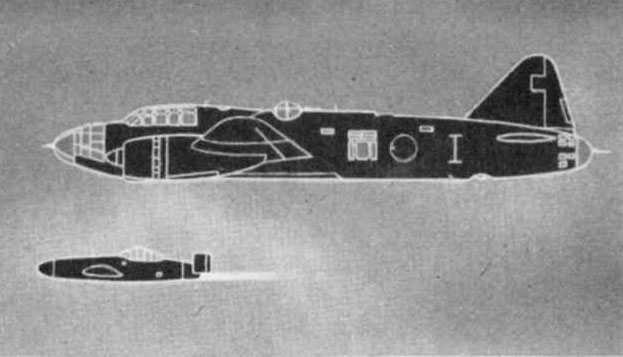
With these limitations on firing time, the need for maximum fire-power is accentuated. Present position opening-fire ranges might well be extended to compensate for the high approach speed of the target.
During its approach, the Baka is subject to three periods of acceleration--one when each rocket is activated. These changes in speed will complicate the fire control problem, as lead angles are computed on a basis of constant speed.
It is estimated that during the 24 seconds burning time of its rocket the Baka, released from a parent plane at 250 knots and reaching a gliding speed of 300 knots before igniting its rockets in sequence, will accelerate as follows:
| Period | Average speed |
Yards covered |
|---|---|---|
| m.p.h. | ||
| First rocket | 350 | 1,368 |
| Second rocket | 450 | 1,760 |
| Third rocket | 550 | 2,152 |
Thus the Baka will have covered the last 3 miles of its attack course in 24 seconds, at an average acceleration of 12.5 m.p.h. for each second of flight. The impact speed under circumstances prevailing in the foregoing table, is 600 m.p.h.
Deflection shots at a crossing Baka will be difficult because of the large lead angles required. Although the Baka is unable to maneuver radically its speed is so great that a slight change in course will create errors as large as if a slower target were maneuvering radically.
Despite its small size and the fact that the wings and tail are of plywood, the Baka will trigger a VT-fuzed projectile at radii of from 30 to 45 feet. Because of its high speed, however, approximately four times as many bursts as against a conventional aircraft may be required to register a kill.
--23--
The Baka's aerodynamic characteristics, which will operate in favor of the ships, include:
1. Heavy wing loading (70.6 pounds per square foot) should cause relatively minor damage to be fatal.
2. Stiffness of controls at high speed, making accurate aiming of the weapon difficult.
Tactics involve a low level final approach, in which the loss of altitude as a result of AA. damage will prove fatal immediately.
Assessment.--Following is an assessment of the new suicide weapon:
1. Simple and economical construction should permit mass production. Rate of production is estimated at 200 monthly.
2. A limiting factor is the number of aircraft required for launching.
3. Lacking launching aircraft it is likely that the weapon will be modified for use from land or ship-based launchers.
4. Baka is so constructed that it appears possible for various types of wings to be attached to the basic fuselage. This presents the possibilities of weapons with long gliding range and greater maneuverability, but lower speed, and of gliders for training use.
5. A jet unit similar to the "V-l robomb" launched from land or ship deck ramps is a possibility.
6. Use of the Baka in night attacks is possible with flares being dropped to silhouette targets and the Baka making a torpedo type run.
7. Current experiments indicate that radar ranging on Baka will be approximately 30 percent of that on a fighter aircraft.
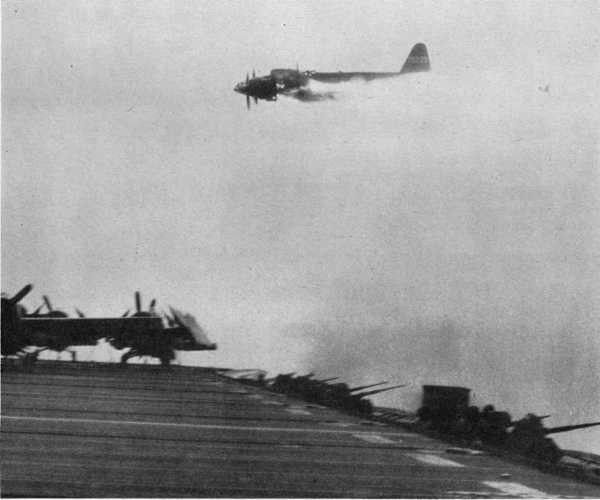
24--
Chapter VI
TASK FORCE 69
This force, under the command of Vice Admiral Willis A. Lee, has been established as an experimental task force under the direct operational control of the commander in chief, United States Fleet, to test methods, procedures, and all types of material in the combat of Jap suicide attacks. On 1 July operations were started.
COMPOSITION OF TASK FORCE 69
U.S.S. Wyoming (AG-17), one cruiser, two destroyers, two destroyer escorts, two LSM's (being fitted with radar equipment), three LcS(L)'s, XVF 200 (30 F6F's, four F4U's, two Zekes) XVJ 25 (drones, tow planes, simulated bogeys).
OPERATING AREA
This force is operating in the Atlantic and the commander in chief, United States Atlantic Fleet, will exercise the administrative control and provide logistic support. At present this force is based at Casco Bay, Portland, Maine.
EXPERIMENTAL PROJECTS
Commander Task Force 69 is concentrating the initial efforts of his force on matters which can be improved in the fleet now and especially on the following projects:
Improvement of early detection and tracking of enemy aircraft by:
More efficient operation of present radar and CIC installations.
Improving these installations by modifications which can be accomplished quickly in the fleet.
Increased effectiveness of antiaircraft fire by:
Antiaircraft fire coordination.
More rapid control.
Increased rate of fire.
Early target acquisition and identification.
Testing new weapons and facilities to evaluate their effectiveness and working out initial operating procedures for their use.
LIST OF EXPERIMENTAL PROJECTS
The following are a list of projects which have been formulated for test and evaluation by CTF 69:
Evaluate use of Army SCR 270/MTI in LSM to determine whether this long range MTI-equipped search radar will assist in detecting and tracking enemy planes over land area near the landing beach.
Evaluate Mark 32 radar IFF interrogator for fire control radar.
Evaluate Field Change 50 for the SG-1 radar.
Determine best procedure for operation cf Mark 37 director for following cases:
No surprise
Ranges greater than 4,000 yards.
Ranges less than 4,000 yards.
Surprise
Ranges less than 4,000 yards.
Evaluate effectiveness of SCR-720 to provide adequate overhead coverage.
Evaluate SC-lc MTI to determine effectiveness of tracking plane through clutter (over land, rough sea, or ships).
Evaluate VJ equipment to determine its usefulness in fighter direction and target designation.
Develop procedure for testing 5"/38 control systems under surprise conditions engaging a maneuvering target.
Evaluate performance of director systems in respect to ability to pickup, track, engage,
--25--
Evaluate comparative performance of Mark 8 and Mark 1 computers with Mark 37 directors.
Evaluate performance of Mark 57 and 37 director systems engaging a maneuvering target in full radar control from maximum effective range.
Evaluate relative performance of Mark 37 and Mark 57 directors against a high speed maneuvering target, engaging at maximum effective range.
Evaluate performance of Mark 15 Mod 1 20-mm. quad mount and Mk 22 Mod 0 (Max-son) quadruple 20-mm. mounts against aircraft targets.
Evaluate effectiveness of high speed cranks in VF in designating targets for main battery director.
Evaluate. SG zenith watch antenna to determine the extent of its effectiveness.
Evaluate relative performance of experienced and inexperienced Mark 37 director and Mark 1 computer teams against a maneuvering target, as a check on effectiveness of training.
Evaluate utility of colored bursts as indicators for shipboard or CAP target designation.
and produce hits with 5"/38 battery on a surprise, high-speed maneuvering target.
Results of tests will be promulgated to the fleet as soon as they have been completed and analyzed. Special emphasis will be placed on the dissemination of information which appears to be of immediate value to the fleet in improving the detection and identification of enemy aircraft and the effectiveness of CAP and AA.
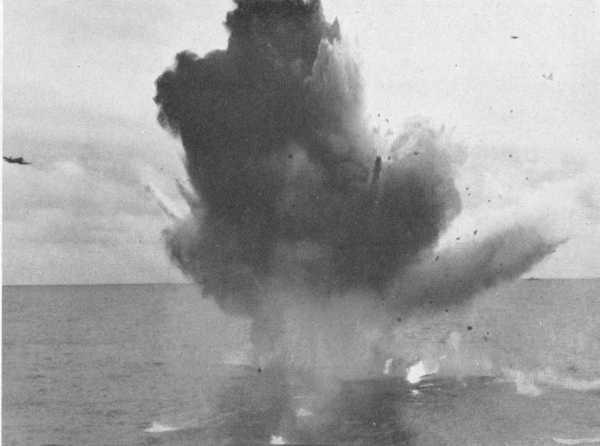
--26--
Chapter VII
NEW WEAPONS
Material bureaus have been developing, at high priority, new weapons and improvements for existing weapons in an effort to provide improved defense against suicide planes. Nevertheless, immediate improvement in our defense can be expected from the expert use of present equipment.
Preliminary information on weapons and equipment which are expected to be available to the fleet by November 1945 is given below.
AIR
1. AEW.--This is a powerful airborne radar which will detect aircraft at ranges up to 70 miles and surface vessels at ranges up to 150-175 miles. Radar returns are relayed from the aircraft to a surface display console on a ship having AEW receiving equipment.
This equipment is being installed in two types of aircraft--the TBM, which will carry 2 radar operators, and the B-17, which will accommodate an airborne CIC. One 4-plane TBM unit will be equipped by 1 October 1945, and 5 other units by 1 November. The first 4-plane element of B-17's will be ready about 1 December, and other units, to a total of 16 planes, will follow as completed through January 1946.
Four surface units are being installed in ESSEX class carriers, and units for smaller ships and amphibious application are expected to be ready for shipment in November. Trained personnel will accompany all AEW installations.
2. Airborne Searchlight for VF(N).--Searchlights have been mounted on F6F aircraft, and tests indicate definite improvements will result from their use in night combat. Benefits include:
(a) The searchlight has a maximum range of 1 mile. Its most effective range for initial illumination is three-eighths to one-half mile.
(b) The pilot of the target plane must shift to instrument flying when illuminated.
(c) Once illuminated, it is very difficult for the target plane to escape the light.
(d) The most effective boresighting range is 400 yards with guns and gunsight.
(e) Gunners in the target plane are unable to oppose the attacking plane effectively because of the loss of dark adaptation and inability to estimate range to the source of the light.
Attempted illuminations on radar information alone have been successful in one-third of the test interceptions, and it is not expected that the airborne searchlight will aid materially in making the initial visual contact. However, once visual contact is established use of the searchlight will expedite positive recognition and assure maintenance of the contact.
It is believed that use of the searchlight on enemy aircraft near our forces will either thwart the attack or delay it until the enemy pilot has regained his night vision.
An experienced unit of ASDevLant has been ordered to ComAirPac to demonstrate the light. Fifty light assemblies are available for combat or training use. BuAer is developing a new light with the following improvements: wider beam (5°), increased power, reduced weight, and better aerodynamic characteristics.
3. Night Fighter Developments.--The F7F night fighter will make its appearance in land-based marine squadrons about 1 October. Squadrons subsequent to the first will have the long-range SCR-720 radar. Having a radar operator, a long-range, wide field radar and the improved visibility of a twin-engine aircraft, the F7F-3(N) is probably the most effective night fighter.
Electronic improvements in the carrier-based field include the APA-48 radar homing device, which will be available for installation in F6F(N)s starting 1 August. This equipment is essentially an APR-1 with a homing antenna of the lobe-switching type, which receives enemy airborne radar and provides homing indications by means of a pilot direction indicator.
Several improvements have been made in the APS-6 radar now carried by the F6F-5(N). These sets now have improved elevation accuracy and increased range. All night fighter pilots are now trained in blind firing using the APS-6 radar,
--27--
and increased accuracy may be expected in this type of attack.
4. New VF Aircraft.---The F8F-1 and F4U-4, which are to replace the F6F-5 and F4U-1, will outperform their predecessors in all respects. The following is a comparison of their performances:
| F8F-1 | F4U-4 | F6F-5 | F4U-1 | |
|---|---|---|---|---|
| Rate of climb (sea level). | 4,600 | 3,600 | 3,250 | 3,400 |
| Maximum mph. (sea level) | 394 | 365 | 344 | 358 |
| Maximum mph. (critical altitude) | 434/19,800 | 445/23,700 | 386/17,400 | 409/19,900 |
| Armament (number guns/rds. per gun) | *4/300 | 6/400 | 6/400 | 6/400 |
*F8F is being prototyped for four 20 mm. guns.
The F7F, to appear first as a land-based fighter, has a performance comparable to the F8F. However, its armament will consist of four 20-mm. and four .50-cal. guns.
These faster fighters will facilitate the investigation of bogeys and make possible the interception and destruction of potential suiciders at longer ranges from surface forces.
RADAR
Probably the most important radar development soon to reach the fleet is the Moving Target Indicator (MTI). This equipment is in effect a modification added to, or built into, radar to blank out the pips from stationary targets and display only moving targets. It makes possible the detection of aircraft either over land masses or in saturation "windows." The following are developments in the radar field which are expected to facilitate defense against suicide planes.
1. Field change No. 60 for SG series radars provides MTI, and the "kits" are being delivered at the rate of 10 per month.
2. For amphibious work, the Army SCR-270 with MTI, will be a valuable addition to the radar net. Six of these equipments, all available, have been shipped to the forward areas.
3. SG Radar Field Change No. 50 improves the performance of these radars by modification of the receiver indicator circuits. A total of 553 conversion kits has been shipped and the present rate of production is 200 per month.
4. SG Radar Field Change No. 54 is a new antenna providing a means of detecting aircraft above 25° position angle. Present range and bearing of target are indicated; in addition, the approximate altitude of the target can lie obtained when the target is directly overhead. With this modification, this installation cannot be used for normal surface search. Equipments totalling 148 have been shipped to the forward areas, and the present contract is completed.
5. SCR-720 is an airborne radar, modified for the zenith watch and shipboard installation. This converted airborne radar is the only zenith watch radar giving range, bearing, and position angle. Maximum reliable range on single-engine aircraft is about 9 miles. Fifty of these sets have been shipped to forward areas for shipborne installation and 90 others will be shipped beginning 15 September.
6. VJ radar repeater is a 12-inch remote PPI designed for general use, including fighter direction. It provides for ranging, target designation, and plotting directly on the face of the instrument. Production commenced in July 1945 at the rate of 10 per month and will reach 150 per month by November.
7. Mark 32 radar is a fire control IFF system for installation on the Mark 4 or Mark 12 fire-control radars. Nearly 200 have been shipped to forward areas and the present rate of production is 150 per month.
ANTIAIRCRAFT
1. Gunfire control system Mark 57.--This medium range, manually operated director system with radar inputs for optical and blind fire control of 40-mm. and 5-inch mounts is being delivered at the rate of 40 per month. There are about 190 installations now in service.
2. Gunfire control system, Mark 60.--This is another, but newer, medium range, manually operated director system for optical and blind firing control of only the 40-mm. gun. Future design will provide for control of the 5-inch batteries. Limited deliveries are expected to commence in September.
--28--
3. Gunfire control system Mark 63--This is a direct outgrowth of the current gun directors Marks 51 and 52. It is a medium-range, manually operated director system for optical or blind firing control of the 40-mm. gun. Delivery of these systems is progressing at the rate of 60 per month. There are about 300 installations in service.
Note.--Each of the above 3 fire control systems is more fully discussed in preliminary form in the Bulletin of Ordnance Information No. 1-45 of 31 March 1945.
4. A total of 280,000 Mark 53 Mod. 3 VT fuzes for 5-inch projectiles has been issued for on-board allowances and shipment to forward areas for issue.
Previous marks and models of the 5-inch VT fuze are to be replaced by the Mark 53 Mod. 3 fuze. The shorter arming time of this fuze increases 5-inch effectiveness in combating suicide attacks. Mods. 4, 5, and 6, similar in performance characteristics to Mod. 3, are in production.
5. A total of 125,000 Mark 58 VT fuzes for 3"/50 projectdes has been issued for onboard allowances and shipment to the forward areas for issue. These fuzes are to replace the Mark 45 VT fuze and while not matching the performance of the Mark 53 fuze, should be more effective than 3-inch time fuzed bursts.
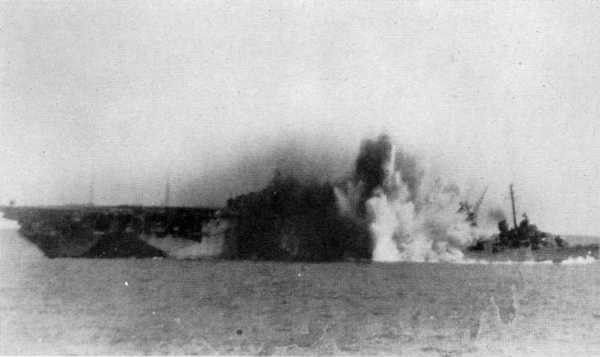
--29--
BIBLIOGRAPHY
Discussions of the suicide problem may be found in the following publications and reports:
CominCh-P-009--(Antiaircraft Action Summary, Suicide Attacks)
CominCh Secret Information Bulletin No. 24--(Battle Experience--Radar Pickets and Methods of Combating Suicide Attacks off Okinawa)
CinCPac-CinCPoa Bulletin 126-45--("Know Your Enemy!")
OpNav-16-V No. A106--(Observed Suicide Attacks by Japanese Aircraft Against Allied Ships)
TAIC Summary No. 31--(Baka)
CinCPac-CinCPoa Bulletin No. 129-45--(Suicide Force Combat Methods)
ComPhibs Pac Serial 00406 of 25 June 1945--(Information on and Comments Concerning Suicide Plane Attacks)
ComPhib Grp 7 Serial 00123 of 16 June 1945--(Counter-Measures Against Suicide Planes)
ComBatRon 1 Memorandum 4-45 of 2 June 1945--(Kamikaze Attacks, Defeating of)
CinCPac-CinCPoa "Weekly Intelligence" Bulletins Nos. 18, 20, 22, 24, 27, 29, 35, 36, 38, 39, 40,41,42,44, 45
CinCPac Conf. Ltr. 15CL--45--(Suicide Bombing Attacks)
CominCh Secret Information Bulletin No. 22
USF 10B
Rad 1A
Rad 6
The CominCh motion picture on "Methods for Combating Suicide Attacks" should be seen by all hands.
--30--
[END]



